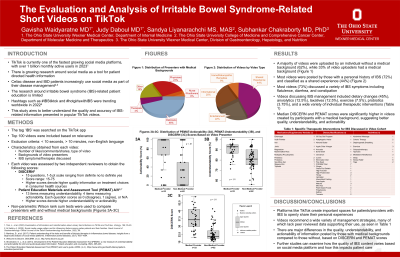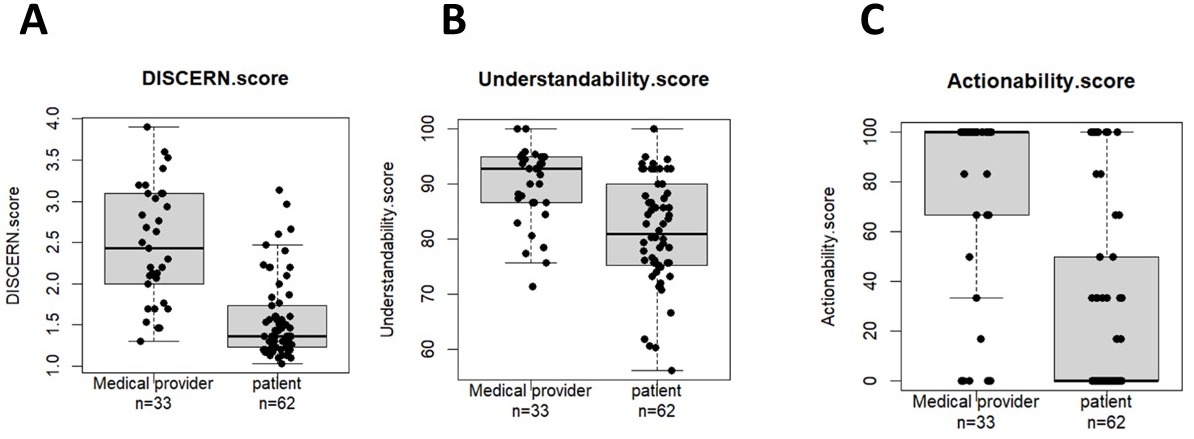Sunday Poster Session
Category: Functional Bowel Disease
P0543 - The Evaluation and Analysis of Irritable Bowel Syndrome Related Short Videos on Social Media (TikTok)
Sunday, October 22, 2023
3:30 PM - 7:00 PM PT
Location: Exhibit Hall

Has Audio

Gavisha Waidyaratne, MD
The Ohio State University Wexner Medical Center
Columbus, OH
Presenting Author(s)
Gavisha Waidyaratne, MD1, Judy Daboul, MD1, Sandya Liyanarachchi, MS, MAS2, Subhankar Chakraborty, MD, PhD2
1The Ohio State University Wexner Medical Center, Columbus, OH; 2The Ohio State University, Columbus, OH
Introduction: TikTok is one of the fastest growing social media platforms in the world. There is ongoing research on the use of social media as a tool for patient education. However, there are concerns that social media can also disseminate poor quality information that can be misleading. While the research around Irritable Bowel Syndrome (IBS)-related patient education on social media is surprisingly limited, IBS has recently become a viral topic of interest amongst TikTok users. Our study objective is to better understand the quality and accuracy of information presented in the most popular IBS-relevant videos on TikTok.
Methods: Videos categorized under the tag ‘IBS’ were sorted by relevance. Exclusion criteria excluded videos that were not relevant to IBS or were < 10 seconds or >10 minutes. In total, 100 videos were reviewed. Baseline characteristics about the video presenter and video content were collected. In addition, the quality of each video was reviewed by two independent reviews using the DISCERN and Patient Education Materials and Assessment Tool (PEMAT) tools, two validated instruments to assess the quality of patient education materials.
Results: Of 100 videos included in this study, 33% were uploaded by a participant with a defined medical background, 62% were uploaded by a participant with a non-medical background, and 5% were unclear. The median DISCERN score of videos uploaded by a participant with a medical background was 2.43 (2.00-3.10) which was significantly higher than participants with a non-medical background 1.37 (1.23-1.70); (p < 0.01). The median PEMAT Understandability score of videos uploaded by a participant with a medical background was 92.86 (86.61-95.00) which was significantly higher than participants with a non-medical background 80.95 (75.76-89.58); (p < 0.01). The median PEMAT Actionability score of videos uploaded by a participant with a medical background was 100.00 (66.67-100.00) which was significantly higher than participants with a non-medical background 0.00 (0.00-45.83); (p < 0.01, Figure 1).
Discussion: These results demonstrate that videos posted by medical professionals are not only easier to understand and to take action on, but are also more reliable, unbiased, and more likely to recommend shared decision making when it comes to treatment. As patients are increasingly turning to social media for health information and recommendations, there is a need for more health professionals to post reliable information.

Disclosures:
Gavisha Waidyaratne, MD1, Judy Daboul, MD1, Sandya Liyanarachchi, MS, MAS2, Subhankar Chakraborty, MD, PhD2. P0543 - The Evaluation and Analysis of Irritable Bowel Syndrome Related Short Videos on Social Media (TikTok), ACG 2023 Annual Scientific Meeting Abstracts. Vancouver, BC, Canada: American College of Gastroenterology.
1The Ohio State University Wexner Medical Center, Columbus, OH; 2The Ohio State University, Columbus, OH
Introduction: TikTok is one of the fastest growing social media platforms in the world. There is ongoing research on the use of social media as a tool for patient education. However, there are concerns that social media can also disseminate poor quality information that can be misleading. While the research around Irritable Bowel Syndrome (IBS)-related patient education on social media is surprisingly limited, IBS has recently become a viral topic of interest amongst TikTok users. Our study objective is to better understand the quality and accuracy of information presented in the most popular IBS-relevant videos on TikTok.
Methods: Videos categorized under the tag ‘IBS’ were sorted by relevance. Exclusion criteria excluded videos that were not relevant to IBS or were < 10 seconds or >10 minutes. In total, 100 videos were reviewed. Baseline characteristics about the video presenter and video content were collected. In addition, the quality of each video was reviewed by two independent reviews using the DISCERN and Patient Education Materials and Assessment Tool (PEMAT) tools, two validated instruments to assess the quality of patient education materials.
Results: Of 100 videos included in this study, 33% were uploaded by a participant with a defined medical background, 62% were uploaded by a participant with a non-medical background, and 5% were unclear. The median DISCERN score of videos uploaded by a participant with a medical background was 2.43 (2.00-3.10) which was significantly higher than participants with a non-medical background 1.37 (1.23-1.70); (p < 0.01). The median PEMAT Understandability score of videos uploaded by a participant with a medical background was 92.86 (86.61-95.00) which was significantly higher than participants with a non-medical background 80.95 (75.76-89.58); (p < 0.01). The median PEMAT Actionability score of videos uploaded by a participant with a medical background was 100.00 (66.67-100.00) which was significantly higher than participants with a non-medical background 0.00 (0.00-45.83); (p < 0.01, Figure 1).
Discussion: These results demonstrate that videos posted by medical professionals are not only easier to understand and to take action on, but are also more reliable, unbiased, and more likely to recommend shared decision making when it comes to treatment. As patients are increasingly turning to social media for health information and recommendations, there is a need for more health professionals to post reliable information.

Figure: Figure 1. Comparison of Discern score (A), Understandability score (B) and actionability score (C) between videos made by medical and non-medical providers
Disclosures:
Gavisha Waidyaratne indicated no relevant financial relationships.
Judy Daboul indicated no relevant financial relationships.
Sandya Liyanarachchi indicated no relevant financial relationships.
Subhankar Chakraborty: Coloplast – Consultant. Medtronic – Consultant.
Gavisha Waidyaratne, MD1, Judy Daboul, MD1, Sandya Liyanarachchi, MS, MAS2, Subhankar Chakraborty, MD, PhD2. P0543 - The Evaluation and Analysis of Irritable Bowel Syndrome Related Short Videos on Social Media (TikTok), ACG 2023 Annual Scientific Meeting Abstracts. Vancouver, BC, Canada: American College of Gastroenterology.

